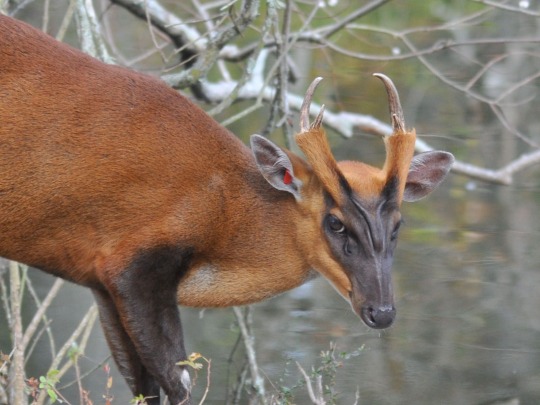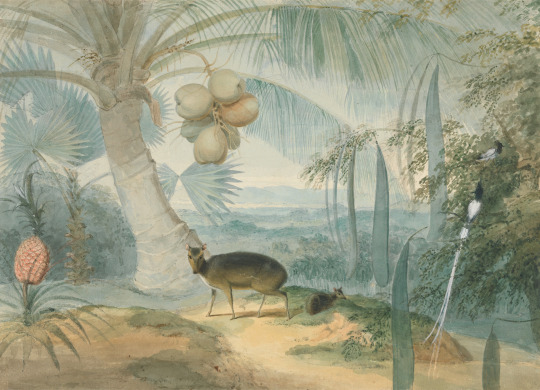#Indian muntjac
Explore tagged Tumblr posts
Text

Southern red muntjac (Muntiacus muntjak)
Formerly known as the Indian or common muntjac, this deer lives in the tropical forests of Southeast Asia. And they’re quite weird. They sport two pairs of large, disturbing-looking scent glands on their faces, which they use to mark their territory. They also have the least chromosomes of any mammal, females with a diploid number of 6 and males with 7. This is about 40 less than their very close relative, the reeve’s muntjac, and 1-2 less chromosomes than a fruit fly!
#markhors-menagerie#animal facts#animals#biology#fun facts#ungulates#even toed ungulates#ruminants#deer & kin#muntjac#southern red muntjac#Indian muntjac#common muntjac
58 notes
·
View notes
Text
Transgendered peruke stags occasionally occur in other species such as Sika Deer (Cervus nippon) – where they may have a female coat color – Roe Deer (Capreolus capreolus), and Fallow Deer (Dama dama). In addition, intersexual individuals combining the genitalia or reproductive organs of both sexes also occur in these species, as do Indian Muntjacs (Muntiacus muntjak) with a combined male-female chromosomal pattern (XXY).
"Biological Exuberance: Animal Homosexuality and Natural Diversity" - Bruce Bagemihl
#book quote#biological exuberance#bruce bagemihl#nonfiction#transgender#peruke#sika deer#cervus nippon#roe deer#capreolus capreolus#fallow deer#dama dama#intersex#reproductive organs#indian muntjac#muntiacus muntjak#chromosomes#xxy
0 notes
Text

#fawnstep#ancient skyclan#skyclan#medicine cat#starclan#based her on an indian muntjac deer#her ears are curled to mimic muntjac horns
6 notes
·
View notes
Text
Month of Saiyuki (day 20)
The Saiyuki boys are in the zombie apocalypse. Who would live the longest?

Despite his human nature, Sanzo is more than able to survive such apocalypse, he also has hunting skills:

Hakkai is another good candidate to live the longest, he can take advantage of the environment, he can heal and is able to survive in the woods:

Goku might have some difficulties but overall he would manage to make it through. If he becomes Seiten Taisei zombies shall pray to survive.
Sorry Gojyo, good fighting skills but he has also a very delicate stomach and seems to prefer a refined lifestyle. With the help of others he can manage to survive.
And now a moment of nerding XD (sorry for long post)
Since I love to analyse things from small details and in this particular case I love to speculate where Sanzo Ikkou is, I've noticed two elements that might give me info about the location. A good indicator is given by Hakkai when he mentions the caterpillar fungus (Ophiocordyceps sinensis). While trying to restrict the areal distribution of this fungus I found this article A survey of the geographic distribution of Ophiocordyceps sinensis by Yi Li , Xiao-Liang Wang, Lei Jiao, Yi Jiang, Hui Li, Si-Ping Jiang, Ngarong Lhosumtseiring, Shen-Zhan Fu, Cai-Hong Dong, Yu Zhan, Yi-Jian Yao. As the title says this study tries to identify the geographic distribution of this fungus used in Tradition Chinese medicine, and I found this map:

This is the link to the original study, but if you want to the entire pdf, there it is: https://docslib.org/doc/11833369/a-survey-of-the-geographic-distribution-of-ophiocordyceps-sinensis
Like the abstract states the fungus can be found in the Tibetan Plateau and its surrounding regions, including Tibet, Gansu, Qinghai, Sichuan, and Yunnan provinces in China and in certain areas of the southern flank of the Himalayas, in the countries of Bhutan, India and Nepal and it is mainly found in the meadows above 3,500 metres.
Another key element that makes me think they might be between Tibetan Plateau and Bhutan is the lagomorph Sanzo is holding by the ears. The possible candidates are: Indian hare (Lepus nigricollis), Woolly hare (Lepus oiostolus) and Hispid hare (Caprolagus hispidus). I immediately rule out the hispid hare because its ears are very short and do not project beyond the fur. The Indian hare is not present in the Tibetan Plateau despite being present in southern part of Bhutan:

Indian Hare area.png by Chermundy, 14 December 2010, is licensed under the Creative Commons Attribution-Share Alike 3.0 Unported license. Attribution: IUCN Red List of Threatened Species, species assessors and the authors of the spatial data.
So the most likely candidate is the woolly hare whose distribution is:

Woolly Hare area.png by Chermundy, 14 December 2010, is licensed under the Creative Commons Attribution-Share Alike 3.0 Unported license. Attribution: IUCN Red List of Threatened Species, species assessors and the authors of the spatial data.
If you want to know more about this hare species here a nice link:
As for the even-toed ungulate we can see, it's a bit difficult a possible identification. The animal might be a member of Cervidae family, maybe an Indian muntjac (Muntiacus muntjak) but yeah without a full picture of the head and antlers it's just a speculation.
Sooooo all of this just to say they are most likely between Tibet and Bhutan XD. Thank you for coming to my Ted Talk. In future I want to talk more about the caterpillar fungus mentioned in these pages. There's a lot to say about this fella.
#saiyuki#kazuya minekura#minekura kazuya#genjyo sanzo#genjo sanzo#month of saiyuki#cho hakkai#son goku
4 notes
·
View notes
Text
हिरण के प्रकार : Types of Deers

हिरण (Deer) Cervidae परिवार के स्तनधारी जीव होते हैं, और इनके कई प्रकार (प्रजातियाँ) पाई जाती हैं। प्रमुख हिरणों के प्रकार निम्नलिखित हैं:
1. भारतीय उपमहाद्वीप ���ें पाए जाने वाले हिरण:
चितल (Axis axis) – सफेद धब्बों वाला सुंदर हिरण, जिसे 'स्पॉटेड डियर' भी कहते हैं।
बारहसिंगा (Rucervus duvaucelii) – इसका नाम इसकी 12 से अधिक शाखाओं वाली सींगों से पड़ा।
सांभर (Rusa unicolor) – भारत का सबसे बड़ा हिरण, जो घने जंगलों में पाया जाता है।
कस्तूर�� मृग (Moschus spp.) – कस्तूरी सुगंध के लिए प्रसिद्ध, यह हिमालयी क्षेत्र में पाया जाता है।
हॉग डियर (Axis porcinus) – यह आकार में छोटा होता है और उत्तर भारत में अधिक मिलता है।
2. विश्व के अन्य हिस्सों में पाए जाने वाले हिरण:
एल्क / वापिटी (Cervus canadensis) – उत्तरी अमेरिका और पूर्वी एशिया में पाया जाता है।
मूस (Alces alces) – दुनिया का सबसे बड़ा हिरण, जिसे उत्तर अमेरिका और यूरोप में 'एल्क' कहा जाता है।
रो डियर (Capreolus capreolus) – यूरोप और एशिया में पाया जाने वाला छोटा हिरण।
रेड डियर (Cervus elaphus) – यूरोप, एशिया और उत्तरी अफ्रीका में पाया जाता है।
फॉलो डियर (Dama dama) – भूमध्यसागरीय क्षेत्रों में पाया जाने वाला धब्बेदार हिरण।
3. दुर्लभ और विलुप्तप्राय हिरण:
पुडलु हिरण (Pudu spp.) – दुनिया का सबसे छोटा हिरण, जो दक्षिण अमेरिका में मिलता है।
पेर डेविड्स डियर (Elaphurus davidianus) – चीन में विलुप्त घोषित, लेकिन अब संरक्षण प्रयासों से दोबारा बढ़ रहा है।
Wildlife of India : भारतीय हिरन और गवय
Indian Wildlife : Bharatiya Hiran — Deer of India
हिरन (DEER)
गवय (ANTELOPE)
सांभर (SAMBHAR)
बारहसिंघा (SWAMP DEER)
हांगुल (KASHMIR STAG)
संगाई (BROW-ANTLERED DEER)
चीतल (SPOTTED DEER)
सूकर-मृग (HOG DEER)
कांकड़ (MUNTJAC)
कस्तूरी-मृग (MUSK DEER)
पिसूरी-मृग (CHEVROTAIN)
नीलगाय (BLUE BULL)
कृष्ण-मृग (BLACK BUCK)
चिंकारा (CHINKARA)
चौसिंघा (FOUR-HORNED ANTELOPE)
हर प्रजाति की अपनी विशेषताएँ होती हैं, और ये दुनिया के विभिन्न हिस्सों में विभिन्न प्रकार के वातावरण में पाए जाते हैं। अधिक जानकारी के लिए ब्लॉग पर जाएं।
1 note
·
View note
Video
youtube
Indian Muntjac rescued from a well in Maharashtra by Wildlife SOS
0 notes
Text
"Sagareshwar deer sanctuary : Rejoice the beauty of nature "

Sagareshwar deer sanctuary is a protected area located at the center of three Tehsils of Sangli district that are Kadegaon, Walva, Palus in the Indian state of Maharashtra. Sagareshwar deer sanctuary is a biosphere reserve. It is a famous sightseeing place in Kolhapur full of natural beauty that will soothe your eyes as well as your mind too.
History of Sagareshwar Deer Sanctuary
Sagareshwar deer sanctuary is famous for its religious, archaeological, and cultural significance. The sanctuary gets its name from an ancient lord Shiva temple. Thousands of devotees visit this temple throughout the year. The construction of the temple is constructed with a variety of stones and the temple is present from the Satvahana period, founded by king Simuka in the 1st century BCE.
Significance of the place
Sagareshwar deer sanctuary was covered by grassy hill slopes. It is a dry mixture and thorn deciduous forest. The sanctuary is popular for its wide variety of flora and fauna including trees like Tamarind, Neem, Acacia, Khair, Nilgiri, vast varieties of deer including, Sambar deer, Chital, blackbucks, Muntjac. Having vast varieties of deer populations makes it a deer sanctuary. Blackbucks are mostly found here.
Blackbucks are the central attraction of this sanctuary. Hyena, fox, porcupines are some small carnivorous animals found in this area. A large population of insects and reptiles is also present here.
The sanctuary preserves the IUCN enlisted endangered species to maintain the threshold extinction level. It also protects the flora and fauna from poachers and predators.
It is spread over a range of 11 square km of the region. August to September is the peak tourism season. It is open at 8:30 AM and closed at 5:00 PM.
Sagareshwar is the most important forest reserve in the world. It is also famous for its hill station and Lord Shiva temples.
How to reach
The best time to visit Sagareshwar Deer Sanctuary is from August to September.
By air: Travelers can reach the Sagareshwar Deer Sanctuary via Kolhapur airport which is 36 km away from the place.
By train: The nearest railway station from the Sagareshwar Deer Sanctuary is Kolhapur railway station which is approximately 67 Km away from the place.
By road: There are regular MSRTC buses that connect Sagareshwar to all the major adjacent areas. These are good quality buses that can handle majority of passengers.
Things to do in Sagareshwar Deer Sanctuary
If you are interested in wildlife then it is a perfect place for you. You can enjoy sunset scenes from the beautiful temple. There is a watchtower, to overlook the entire forest.
Hiking to the top of a hill in the sanctuary is the most popular tourist activity. Flowing of the Krishna River through the fields of grapevines and sugarcane is another site of attraction. Lord Shiva temple also creates a center of attraction as it is the source of devotion to the people.
Conclusion
Enjoy the essence of nature and wildlife in the sanctuary during jeep safaris.
You can also spend a golden time with your family and loved ones by taking pictures at the grassy hill slopes.
0 notes
Text
Indian Cuisine in the Global Spotlight: Michelin-Starred Restaurants
Indian cuisine, with its rich tapestry of flavours, aromas, and colours, has long captivated food enthusiasts worldwide. In recent years, this diverse and vibrant culinary tradition has found itself in the global spotlight, with several Indian restaurants receiving the prestigious Michelin stars. These accolades not only highlight the exceptional skills of Indian chefs but also signify the growing appreciation for the complexity and depth of Indian gastronomy on an international stage.
A Journey of Culinary Excellence
The journey of Indian cuisine to Michelin stardom has been a fascinating one, marked by a blend of tradition, innovation, and unwavering dedication to quality. Traditionally, Indian food was associated with street stalls, family-run eateries, and bustling markets, where flavours exploded in a riot of spices and textures. While these grassroots establishments continue to thrive, the emergence of fine dining Indian restaurants has added a new dimension to the culinary landscape.
Breaking Stereotypes: The Evolution of Indian Fine Dining
Gone are the days when Indian cuisine abroad was synonymous with heavy curries and greasy dishes. Michelin-starred Indian restaurants have played a pivotal role in challenging these stereotypes by presenting a refined and nuanced version of Indian cooking. These establishments artfully blend traditional recipes with contemporary techniques, offering diners a culinary experience that is both familiar and innovative.
Showcasing Regional Diversity
One of the most remarkable aspects of Indian cuisine is its incredible diversity, shaped by centuries of history, geography, and cultural influences. Michelin-starred Indian restaurants have embraced this diversity, showcasing regional specialties that range from the fiery flavours of Andhra Pradesh to the delicate aromas of Kashmiri cuisine. Each dish tells a story, reflecting the unique traditions and ingredients of its place of origin.
Elevating Ingredients and Techniques
Achieving a Michelin star requires a meticulous attention to detail, and Indian chefs have risen to the challenge admirably. From sourcing the freshest spices to using traditional cooking techniques with a modern twist, these culinary maestros spare no effort in creating dishes that are as visually stunning as they are delicious. The art of tandoori cooking, the delicate balance of spices in a biryani, and the intricacy of a perfectly layered dosa—all find their place on the menus of these acclaimed restaurants.
Michelin-Starred Trailblazers
Several Indian restaurants have earned the coveted Michelin stars, shining a spotlight on the brilliance of Indian chefs and the depth of the country's culinary heritage.
Gymkhana, London
Located in the heart of London, Gymkhana holds a Michelin star for its modern take on Indian cuisine. The restaurant offers a menu that celebrates the flavours of the Indian subcontinent while adding contemporary twists. Dishes like Wild Muntjac Biryani and Old Delhi-style Butter Chicken have become signature favourites among patrons.
Gaggan Anand, Bangkok
While not strictly a traditional Indian restaurant, Gaggan Anand's eponymous establishment in Bangkok earned two Michelin stars for its innovative approach to Indian flavours. Known for its progressive Indian cuisine, the restaurant takes diners on a culinary journey with dishes like Lick It Up, a playful take on the classic street food, and Charcoal, which presents a deconstructed version of the traditional Indian bread, naan.
Rasoi by Vineet, Geneva
In the picturesque city of Geneva, Rasoi by Vineet stands out as a Michelin-starred gem. Helmed by Chef Vineet Bhatia, the restaurant offers a blend of traditional Indian flavours with a contemporary presentation. Dishes such as Tandoori Lobster and Lucknow-style Lamb Kebabs have garnered praise for their exquisite flavours and artful plating.
The Global Influence of Indian Cuisine
The recognition of Indian restaurants on the Michelin stage is not just a celebration of individual chefs and establishments; it is a testament to the global influence of Indian cuisine. From London to Bangkok, Geneva to New York, diners are discovering the depth, complexity, and sheer joy of Indian flavours.
Cultural Exchange Through Food
Food has an unparalleled ability to bridge cultures, and Indian cuisine, with its myriad influences and flavours, serves as a perfect ambassador. Michelin-starred Indian restaurants often become hubs of cultural exchange, welcoming guests from diverse backgrounds to experience a taste of India's rich culinary heritage.
Inspiring a New Generation
The success of Indian restaurants on the Michelin scene has inspired a new generation of chefs to explore the boundaries of Indian cuisine further. Young cooks, both in India and abroad, are experimenting with traditional recipes, local ingredients, and global techniques, creating a culinary fusion that is as exciting as it is delicious.
As Indian cuisine continues to dazzle palates around the world, the presence of Michelin-starred Indian restaurants serves as a beacon of excellence and innovation. These establishments not only elevate traditional recipes to new heights but also introduce diners to the incredible diversity and depth of India's culinary traditions. Whether it's a fragrant biryani in London, a modern take on street food in Bangkok, or an artfully plated dish in Geneva, Michelin-starred Indian restaurants invite us on a journey of flavours, aromas, and experiences that celebrate the very best of Indian gastronomy on a global stage.
For more information visit- top Indian restaurants Bella Vista
Jheel
G02/8 Century Cct, Norwest
NSW 2153,
Australia
Contact no: 02 9894 7766 Email: [email protected]

0 notes
Photo

The other fanged deer, Muntjac!
48 notes
·
View notes
Photo

Indian muntjac
Photographer: Lertnapa Bongbut
9 notes
·
View notes
Photo

Indian Muntjac by cvsk
1 note
·
View note
Text

For #WatercolorWednesday:
Samuel Daniell (British, 1775–1811) A Landscape in Ceylon, With Barking Deer and Fawn and a Pair of Paradise Fly-Catchers between 1808 and 1811 Watercolor, over graphite, with pen in brown ink and gouache on medium, moderately textured, beige, wove paper Yale Center for British Art, Paul Mellon Collection, B2006.14.16.
The pecies depicted are the Southern Red Muntjac (Muntiacus muntjak) and white morph Indian Paradise Flycatcher (Terpsiphone paradisi).
#barking deer#southern red muntjac#paradise flycatcher#indian paradise flycatcher#color morph#bird#birds#birds in art#mammal#mammals#landscape#painting#watercolor#illustration#natural history art#Ceylon#Sri Lanka#19th century art#European art#British art#Samuel Daniell#Yale Center for British Art#Watercolor Wednesday#animals in art
8 notes
·
View notes
Text
All cervids in the Smithsonian Museum of Natural History are male aside from a single whitetailed doe:)
#buggyposting#thats ur fact for today#the doe has a fawn with her and idk ab the fawn tho whoops#but uhm yea#theres a mule deer buck and bull irish elk skeleton and taxidermies of a bull moose a male indian muntjac and a male chinese water deer#THERES ALSO A MALE FALLOW DEER IM SORRY I FORGOT U SIR
4 notes
·
View notes
Photo

Indian Muntjac by cvsk Aerials Harrogate
0 notes
Photo

Indian Muntjac
0 notes
